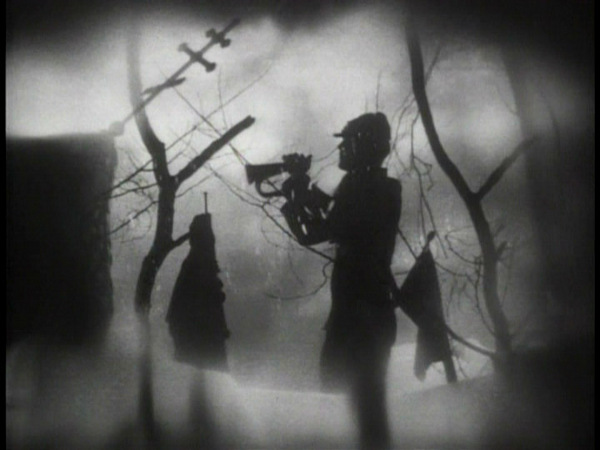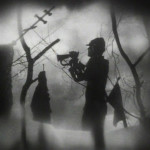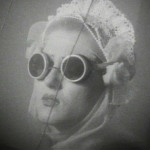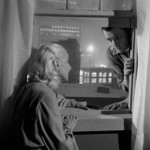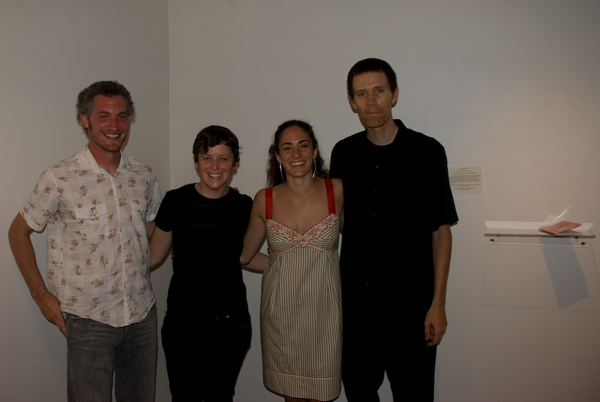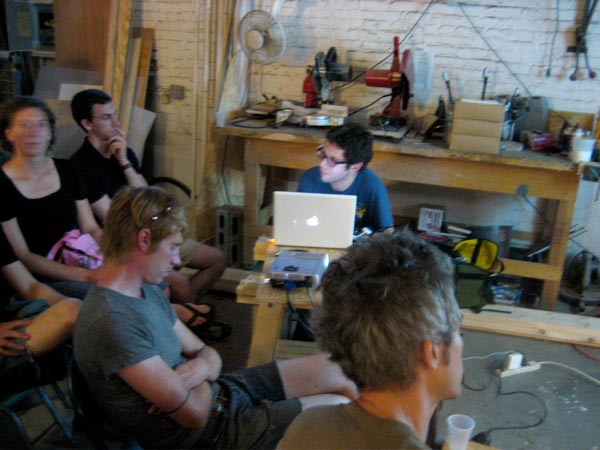Amnesia, obsession, malformed or multiple identity, melodramatic unrequited love, silent film accompanied by disembodied (intertitled) voice and rhythmic sound, coexistence of past, present and future from which dream and memory derive, insular family tableaux against changing, absurdist-world and always, comedy in pathos. These are threads that Guy Maddin has dramticized in his films work. His latest offering, My Winnipeg, uses them all.
My Winnipeg opens with portrait, not unlike an early Eisenstein film. This kind of claustrophobic framing creates as isolation and entrapment of a passenger bound for nowhere. He dreams escape, “must get out…”, if only he can stay awake long enough. Isolationism is narrated in lo-fi monotone and depicted in the passenger’s out-of-body, sleepwalking persona off to childhood home to re-arrange life for the better. Other sleepwalkers travel this way, silhouetted against bright white snow and moon-black sky. The character of the sonabulist is classic in early expressionist films like, The Cabinet Of Dr. Caligari, an unpredictable body representing unconscious control - possessed by unpredictable dreams and the numbness induced by the modern world. This kind of placement into cinematic history, pitches the viewer out of the contemporary and into another unspecified time.
Continuing this illusion, Maddin's lo-fi narration in the film makes the film feel as though it were from the silent era. Constant narration creates hypnotic tempo. “ I must leave, I must leave now…” This perpetuates dreamscape and invites us in, so we too may float upon vital memory. The use of hypnotic rhythm may also be heard in the chug of the train. This is most evident in a scene at the municipal building where dancer, prostitutes and founding fathers conduct a séance. Voice touching from a distance, never diminishes silence or tableaux, creating scenes more poignant than Griffith’s Broken Blossoms or Yonggang’s The Goddess.
In the film, Maddin exaggerates family relationships, articulating the comfort and disturbance in a home. In My Winnipeg, Mother is portrayed by Ann Savage (whose voice and dimpled-face remains the same as it was in as, One Dangerous Night, released in 1943). It’s as if racing-time freezes for Ann, through the detached narrative and disassociation of place though the editing. In her role as Mother, she’s “more powerful than all the trains in Manitoba,” as Maddin says. She knows and sees all, even beyond death. Thus the lovely exchange of intimacy between cyclonic-mom and spirit-son in My Winnipeg when she asks if he’s “comfortable” after death. Here time stops like a train so the dead may catch up to the living, touch and make peace.
Many of the motifs in My Winnipeg can be traced back to one his earlier films, Archangel. Archangel is a town in northernmost Russia, as cold and isolated as Winnipeg. Maddin explains we are in the town Archangel in 1919. The Great War is over though no one informs the inhabitants who continue to fight. In Archangel, Boles obsessively searches for his lost Iris, beyond death and time. In the end we are our own time; and memory and peaceful oblivion is all that remains.
Using a unique mix of historic styles of early cinema, Maddin is able to create content that immediately immersed in narrative, no matter how oblique. Though, My Winnipeg does not use these styles for the sake of making a period piece, or a tribute film. Instead, Maddin is able to locate how contemporary viewers sense cinematic pastness as a world apart, which only accentuates the disembodied time and interior dialogue used throughout the course of the film.
- A still from Guy Maddin’s My Winnipeg
- Stills from Guy Maddin’s Archangel.
INTERVIEW WITH GUY MADDIN, DIRECTOR OF MY WINNIPEG by JAMES NADEAU in issue #86
All images found here.

